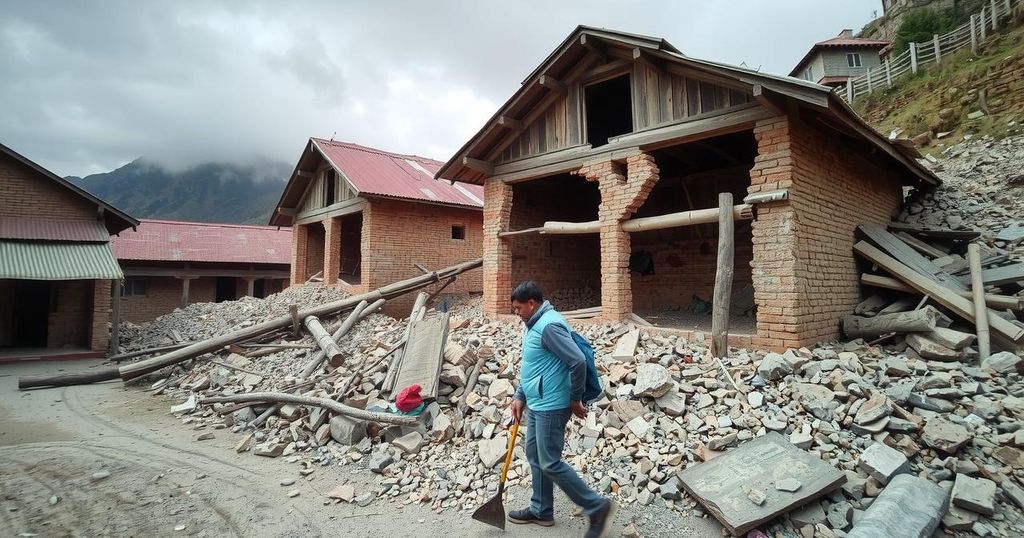Weather
World news
ASIA, BUILDING COLLAPSE, CC, CCTV, CHINA, DINGRI, EUROPE, FLOODS, FRANCE, HIMALAYAN, LANDSLIDES, MEXICO, MOUNT EVEREST, NATIONAL EARTHQUAKE AGENCY, NATURAL DISASTERS, NORTH AMERICA, RESCUE OPERATIONS, TIBET, UNITED STATES GEOLOGICAL SURVEY, XI JINPING, XINHUA, XINHUA NEWS AGENCY
Lena Nguyen
0 Comments
Severe Earthquake in Tibet Causes Widespread Destruction and Loss of Life
On January 7, a 6.8 magnitude earthquake struck Dingri, Tibet, demolishing 80-90% of homes in the hardest-hit villages. The disaster has resulted in at least 126 fatalities and left hundreds injured, with rescue efforts impeded by extreme cold and aftershocks. President Xi Jinping has urged immediate action and support for those affected.
On January 7, at 9 AM local time, a powerful earthquake measuring 6.8 on the Richter scale struck Dingri, a rural county in southern Tibet. The tremor, which has been reported as 7.1 by the U.S. Geological Survey, resulted in extensive destruction, collapsing 80-90% of the houses in the worst-affected villages. The latest reports indicate that at least 126 individuals have lost their lives while 188 others have sustained injuries according to China’s Xinhua News Agency. Furthermore, approximately 6,900 people reside within 20 kilometers of the quake’s epicenter.
In the immediate aftermath of the disaster, thousands of skilled rescue workers and military personnel tirelessly worked to extract individuals trapped in the debris. However, the frigid temperatures in the Himalayan foothills, which range from -8ºC during daylight to -18ºC at night, pose significant challenges to survival. The earthquake occurred at an altitude of 4,200 meters, approximately 75 kilometers from Mount Everest, complicating rescue operations further. Following the initial quake, several aftershocks were reported, raising concerns about additional collapses in the already fragile structures.
Visuals shared by national media and social networks depicted the devastation of the area, with small white houses, typical of rural China, reduced to mere piles of rubble. Distressing scenes showed the deceased trapped beneath collapsed buildings and livestock casualties, provoking anguish among survivors. In response to this calamity, President Xi Jinping emphasized the need for unrelenting efforts in search and rescue operations, urging that measures be taken to minimize further loss of life and to ensure the relocation of those adversely affected by the disaster.
The recent earthquake in Dingri, Tibet, is a reminder of the vulnerability of communities situated in seismically active regions. This area, part of the Himalayan foothills, has a history of earthquakes but rarely experiences a disaster of this magnitude. The social and economic impacts of such natural disasters can devastate local populations, especially in rural areas where infrastructure may not be resilient enough to withstand such tremors. Understanding the geographical and climatic context is vital, as the harsh conditions following the earthquake complicate relief efforts and increase the risk for survivors.
In summary, the January 7 earthquake in Dingri, Tibet, has resulted in a tragic loss of life and widespread devastation, with reports indicating that 80-90% of houses in the hardest-hit areas have collapsed. Rescue operations face significant challenges due to extreme weather conditions and aftershocks, yet efforts continue to save those trapped. The incident underscores the importance of preparedness in seismically active regions and highlights the urgent need for effective disaster response strategies.
Original Source: www.lemonde.fr




Post Comment